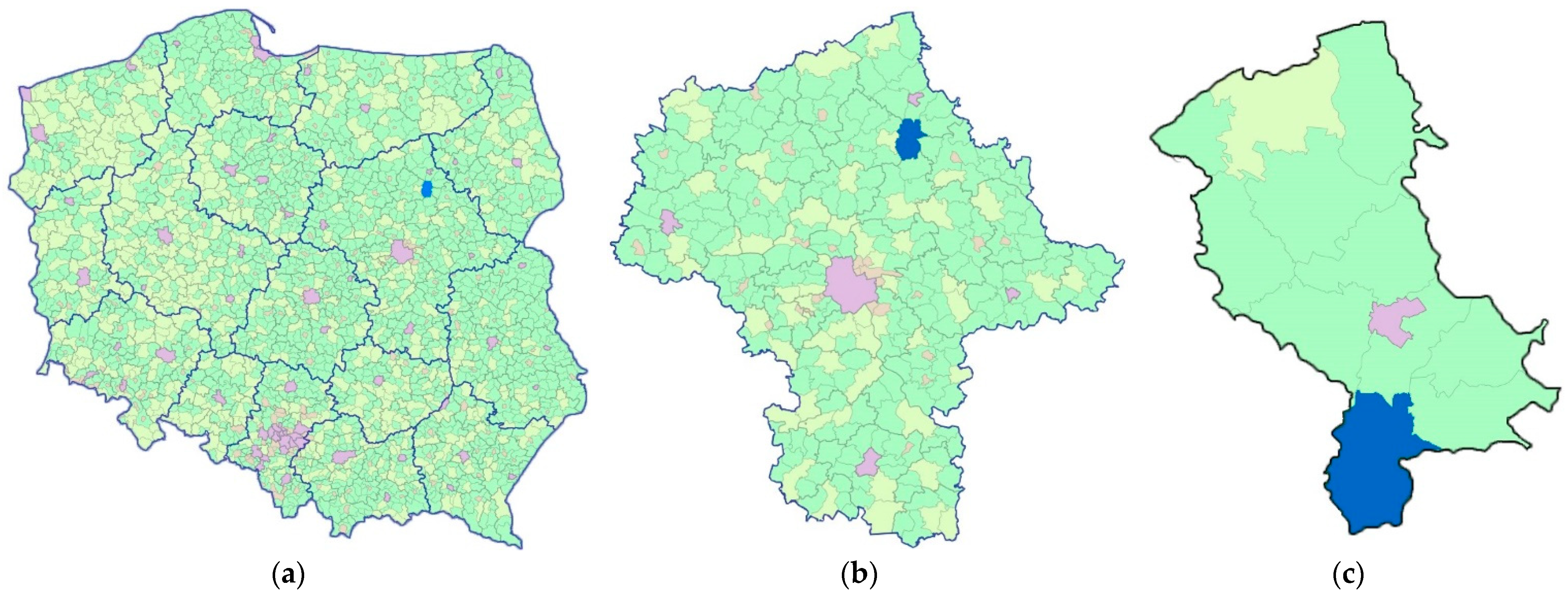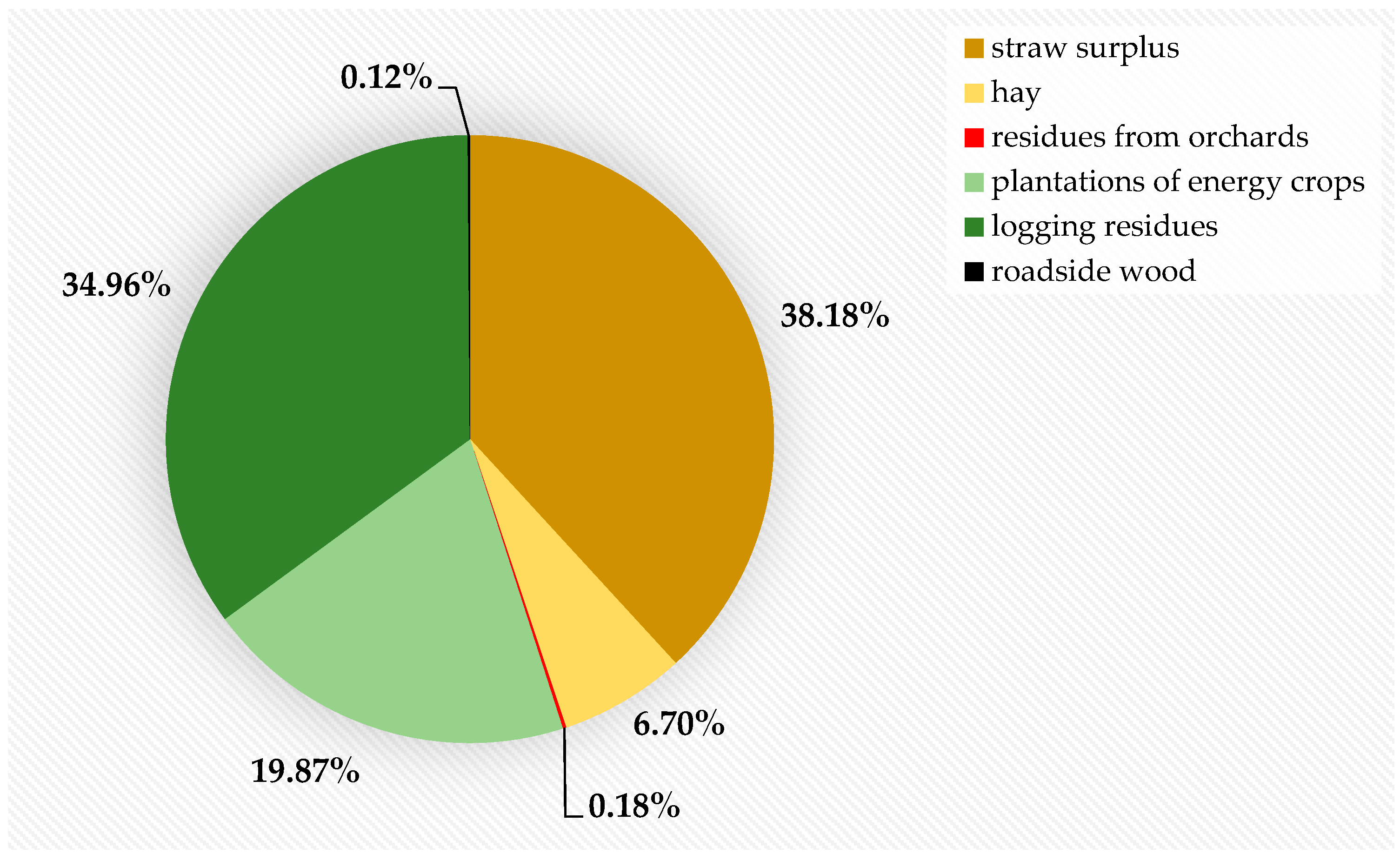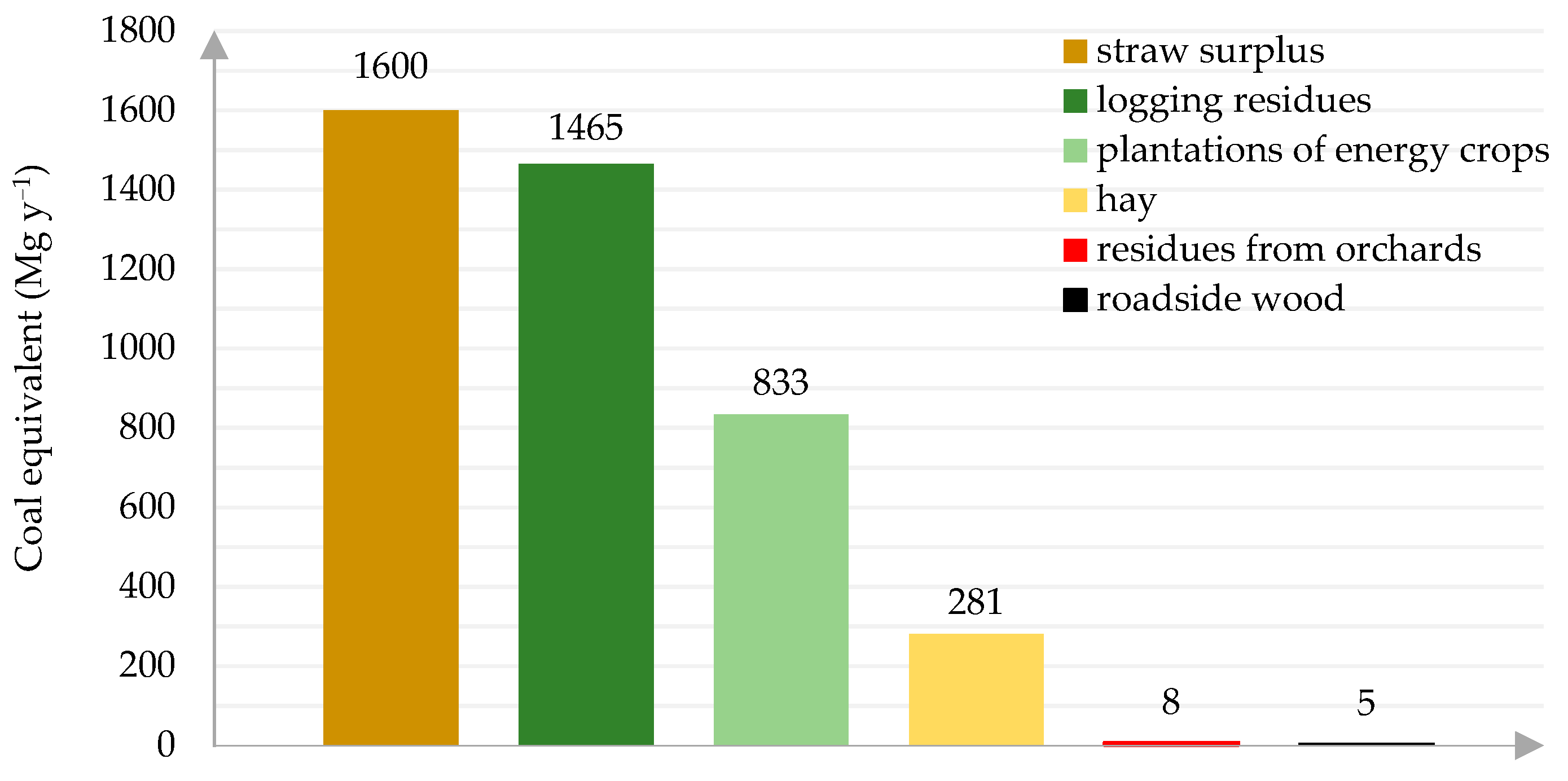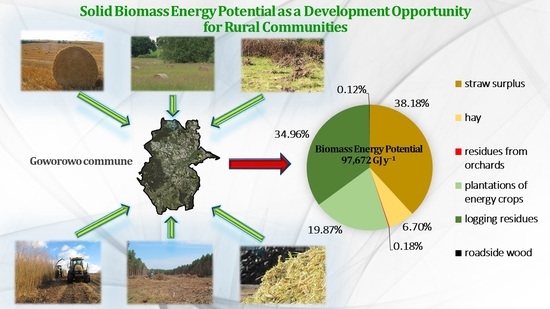Solid Biomass Energy Potential as a Development Opportunity for Rural Communities
Abstract
1. Introduction
2. Materials and Methods
2.1. Characteristics of the Commune
2.1.1. Administrative Affiliation and General Information
2.1.2. Land Use
2.1.3. Structure of Agricultural Land
2.2. Determination of Biomass Resources and Their Energy Potential
2.2.1. Straw
2.2.2. Orchard Wood Residue
2.2.3. Energy Feedstock from Forests
2.2.4. Solid Biomass from Roadside Maintenance
- supralocal roads: 13.5 km of the trunk road and 101.3 km of district roads;
- local roads: 123.7 km of communal roads.
2.2.5. Biomass from Perennial Energy Crops
2.2.6. Hay from Meadows and Pastures
2.2.7. Landfilled Sludge and Municipal Waste
3. Results and Discussion
3.1. Straw Potential
3.2. Orchard Potential
3.3. Forest Potential
3.4. Roadside Potential
3.5. Potential of Perennial Energy Crops
3.6. Potential of Permanent Grassland
3.7. Potential of the Landfilled Sludge and Municipal Waste
3.8. Commune Potential
4. Conclusions
Author Contributions
Funding
Acknowledgments
Conflicts of Interest
References
- Kluczkowski, A. The use of wood biomass in the regional system of renewable energy sources as a chance for the region. J. Vasyl Stefanyk Precarpathian Natl. Univ. 2017, 4, 67–73. [Google Scholar] [CrossRef][Green Version]
- Rosales-Calderon, O.; Arantes, V. A review on commercial-scale high-value products that can be produced alongside cellulosic ethanol. Biotechnol. Biofuels 2019, 12, 240. [Google Scholar] [CrossRef]
- Brodny, J.; Tutak, M.; Saki, S.A. Forecasting the structure of energy production from renewable energy sources and biofuels in Poland. Energies 2020, 13, 2539. [Google Scholar] [CrossRef]
- Marks-Bielska, R.; Bielski, S.; Pik, K.; Kurowska, K. The importance of renewable energy sources in Poland’s energy mix. Energies 2020, 13, 4624. [Google Scholar] [CrossRef]
- Brodny, J.; Tutak, M. Analyzing similarities between the european union countries in terms of the structure and volume of energy production from renewable energy sources. Energies 2020, 13, 913. [Google Scholar] [CrossRef]
- Sefeedpari, P.; Pudełko, R.; Jędrejek, A.; Kozak, M.; Borzęcka, M. To what extent is manure produced, distributed, and potentially available for bioenergy? A step toward stimulating circular bio-economy in Poland. Energies 2020, 13, 6266. [Google Scholar] [CrossRef]
- Statistics Poland. Energy from Renewable Sources in 2018. 2019. Available online: https://stat.gov.pl/obszary-tematyczne/srodowisko-energia/energia/energia-ze-zrodel-odnawialnych-w-2018-roku,10,2.html (accessed on 12 February 2021).
- Eurostat. Energy Data—2020 Edition. 2020. Available online: https://ec.europa.eu/eurostat/web/products-statistical-books/-/KS-HB-20-001 (accessed on 13 February 2021).
- Statistics Poland. Energy Statistics in 2018 and 2019. 2020. Available online: https://stat.gov.pl/obszary-tematyczne/srodowisko-energia/energia/gospodarka-paliwowo-energetyczna-w-latach-2018-i-2019,4,15.html (accessed on 12 February 2021).
- Eurostat. 2019. Available online: https://ec.europa.eu/eurostat/data/statistics-a-z/abc (accessed on 2 April 2021).
- Statistics Poland. Energy from Renewable Sources in 2019. 2020. Available online: https://stat.gov.pl/obszary-tematyczne/srodowisko-energia/energia/energia-ze-zrodel-odnawialnych-w-2019-roku,3,14.html (accessed on 2 April 2021).
- Stolarski, M.J.; Warmiński, K.; Krzyżaniak, M.; Olba-Zięty, E.; Stachowicz, P. Energy consumption and heating costs for a detached house over a 12-year period—Renewable fuels versus fossil fuels. Energy 2020, 204, 117952. [Google Scholar] [CrossRef]
- Vezzoli, C.; Ceschin, F.; Osanjo, L.; M’Rithaa, M.K.; Moalosi, R.; Nakazibwe, V.; Diehl, J.C. Distributed/decentralised renewable energy systems. In Designing Sustainable Energy for All, 1st ed.; Vezzoli, C., Ceschin, F., Osanjo, L., M’Rithaa, M.K., Moalosi, R., Nakazibwe, V., Diehl, J.C., Eds.; Springer: Cham, Switzerland, 2018; pp. 23–39. [Google Scholar]
- Kluczkowski, A.; Wyrostkiewicz, M. Circular economy as an important subject of environmental education in the era of energy demand. J. Vasyl Stefanyk Precarpathian Natl. Univ. 2018, 5, 88–94. [Google Scholar] [CrossRef][Green Version]
- Statistics Poland. Area and Population in the Territorial Profile in 2020. 2020. Available online: https://stat.gov.pl/obszary-tematyczne/ludnosc/ludnosc/powierzchnia-i-ludnosc-w-przekroju-terytorialnym-w-2020-roku,7,17.html (accessed on 14 March 2021).
- Kaczmarek, T. Communal administrative division in the light of 25 years of operation of local government in Poland. Political Sci. Rev. 2016, 1, 63–80. [Google Scholar]
- Rokicki, T.; Perkowska, A.; Klepacki, B.; Bórawski, P.; Bełdycka-Bórawska, A.; Michalski, K. Changes in energy consumption in agriculture in the EU countries. Energies 2021, 14, 1570. [Google Scholar] [CrossRef]
- Rocha-Meneses, L.; Bergamo, T.F.; Kikas, K. Potential of cereal-based agricultural residues available for bioenergy production. DataBrief 2019, 23, 103829. [Google Scholar] [CrossRef] [PubMed]
- Steubing, B.; Zah, R.; Waeger, P.; Ludwig, C. Bioenergy in Switzerland: Assessing the domestic sustainable biomass potential. Renew. Sustain. Energy Rev. 2010, 14, 2256–2265. [Google Scholar] [CrossRef]
- Avcıoğlu, A.O.; Dayıoğlu, M.A.; Türker, U. Assessment of the energy potential of agricultural biomass residues in Turkey. Renew. Energy 2019, 138, 610–619. [Google Scholar] [CrossRef]
- Stolarski, M.J.; Warmiński, K.; Krzyżaniak, M.; Olba-Zięty, E.; Akincza, M. Bioenergy technologies and biomass potential vary in Northern European countries. Renew. Sustain. Energy Rev. 2020, 133, 110238. [Google Scholar] [CrossRef]
- Kowalczyk-Juśko, A.; Listosz, A.; Mazur, K.; Macig, M.; Pochwatka, P.; Mazur, A. The state and the perspectives of the eco-energy infrastructure development in Biała Podlaska County (Poland). Part II Estimation of solid biomass resources for energy purposes. E3S Web Conf. 2020, 171, 01005. [Google Scholar] [CrossRef]
- Mayor of the Goworowo Commune. Report on the State of the Goworowo Commune. 2020. Available online: http://goworowo.pl/wp-content/uploads/2020/05/Goworowo_raport_o_stanie_gminy_2019.pdf (accessed on 21 January 2021).
- Poland’s Open Data Portal. Open Spatial Data Geoportal. 2021. Available online: https://polska.e-mapa.net/ (accessed on 2 April 2021).
- Statistics Poland. Statistical Vademecum of a Local Government. 2020. Available online: https://warszawa.stat.gov.pl/statystyczne-vademecum-samorzadowca/ (accessed on 12 March 2021).
- Mayor of the Goworowo Commune. Environmental Protection Program for the Goworowo Commune. 2019. Available online: http://goworowo.pl/wp-content/uploads/2019/09/Program-Ochrony-%C5%9Arodowiska.pdf (accessed on 20 January 2021).
- Mayor of the Goworowo Commune. The Basic Ecophysiographic Study Prepared for the Needs of Study of the Conditions and Directions of Spatial Development in the Commune of Goworowo (Local Document Provided by the Goworowo Commune Office on Request); Goworowo Commune Office: Goworowo, Poland, 2013. [Google Scholar]
- Marshal’s Office of the Mazowieckie Voivodeship. Spatial Information System for the Mazowieckie Voivodeship. 2021. Available online: https://msip.wrotamazowsza.pl/msip/Full.aspx (accessed on 13 January 2021).
- Statistics Poland. Land Use and Sown Area in 2019. 2020. Available online: https://stat.gov.pl/obszary-tematyczne/rolnictwo-lesnictwo/rolnictwo/uzytkowanie-gruntow-i-powierzchnia-zasiewow-w-2019-roku,8,15.html (accessed on 7 December 2020).
- Marshal’s Office of the Mazowieckie Voivodeship. A Summary of the Data from the Land and Building Register of the Mazowieckie Voivodship. 2019. Available online: https://gis.wrotamazowsza.pl/bezplatne-dane/ (accessed on 7 December 2020).
- Minister of Investment and Development. The Ordinance on Land and Building Register. 2019. Available online: https://isap.sejm.gov.pl/isap.nsf/DocDetails.xsp?id=WDU20190000393 (accessed on 7 December 2020).
- Statistics Poland. The Resulting Estimate of the Main Agricultural and Horticultural Crops. 2020. Available online: https://stat.gov.pl/obszary-tematyczne/rolnictwo-lesnictwo/uprawy-rolne-i-ogrodnicze/wynikowy-szacunek-glownych-ziemioplodow-rolnych-i-ogrodniczych-w-2020-roku,5,19.html (accessed on 11 January 2021).
- Warmia and Mazury Agricultural Advisory Center. Review of Polish Maize Varieties. 2018. Available online: https://wmodr.pl/files/tnUefXPeFS3uEU5QOPGyrGyiNp0JhC3jzRTxCAJz.pdf (accessed on 11 January 2021).
- Hryniewicz, M.; Grzybek, A. Available straw surplus for use for energy purposes in 2016. Probl. Agric. Eng. 2017, 3, 15–31. [Google Scholar]
- Bieranowski, J.; Olkowski, J. The concept of an energy self-sufficient farm system compatible with sustainable development in a selected region in Poland. Pol. J. Environ. Stud. 2016, 25, 529–544. [Google Scholar] [CrossRef]
- Stolarski, M.J.; Rybczyńska, B.; Krzyżaniak, M.; Lajszner, W.; Graban, Ł.; Peni, D.; Bordiean, A. Thermophysical properties and elemental composition of agricultural and forest solid biofuels versus fossil fuels. J. Elem. 2019, 24, 1215–1228. [Google Scholar] [CrossRef]
- Roman, M.; Roman, K. Energy use of wood waste from fruit trees on the example of an agritourism farm. Ann. Pol. Assoc. Agric. Agribus. Econ. 2018, XX, 158–161. [Google Scholar]
- Dyjakon, A.; den Boer, J.; Bukowski, P.; Adamczyk, F.; Frąckowiak, P. Wooden biomass potential from apple orchards in Poland. Wood Res. Pap. Rep. Announc. 2016, 59, 73–86. [Google Scholar]
- Cichy, W.; Witczak, M.; Walkowiak, M. Fuel properties of woody biomass from pruning operations in fruit orchards. BioResources 2017, 12, 6458–6470. [Google Scholar] [CrossRef]
- Swithenbank, J.; Chen, Q.; Zhang, X.; Sharifi, V.; Pourkashanian, M. Wood would burn. Biomass Bioenergy 2011, 35, 999–1007. [Google Scholar] [CrossRef]
- Statistics Poland. Statistical Yearbook of Forestry. 2020. Available online: https://stat.gov.pl/obszary-tematyczne/roczniki-statystyczne/roczniki-statystyczne/rocznik-statystyczny-lesnictwa-2020,13,3.html (accessed on 5 March 2021).
- Forest District Ostrołęka. Forest Management Plan. 2012. Available online: https://bip.lasy.gov.pl/pl/bip/dg/rdlp_olsztyn/nadl_ostroleka/plan_urzadzania_lasu/czesc_opisowa (accessed on 5 March 2021).
- Forest District Pułtusk. Forest Management Plan. 2014. Available online: https://bip.lasy.gov.pl/pl/bip/dg/rdlp_warszawa/nadl_pultusk/plan_urzadzania_lasu/czesc_opisowa (accessed on 5 March 2021).
- Forest District Wyszków. Forest Management Plan. 2017. Available online: https://bip.lasy.gov.pl/pl/bip/dg/rdlp_warszawa/nadl_wyszkow/plan_urzadzania_lasu/czesc_opisowa (accessed on 5 March 2021).
- Gendek, A.; Wężyk, P.; Moskalik, T. Share and accuracy of estimation of logging residues in the total volume of harvested timber. Sylwan 2018, 162, 679–687. [Google Scholar]
- Różański, H.; Jabłoński, K. Prospects for forest biomass harvesting for energy purposes in Poland. J. Civ. Eng. Environ. Archit. 2015, XXXII, 351–358. [Google Scholar] [CrossRef]
- Order of the General Director of State Forests. Technical Conditions—Division, Terminology and Symbols Used in the Turnover of Wood Raw Material. 2019. Available online: http://drewno.zilp.lasy.gov.pl/drewno/Normy/ (accessed on 6 March 2021).
- National Forest Holding the State Forests. Report on the Condition of Forests in Poland. 2020. Available online: https://www.lasy.gov.pl/pl/informacje/publikacje/informacje-statystyczne-i-raporty/raport-o-stanie-lasow/raport-o-stanie-lasow.pdf/view (accessed on 6 March 2021).
- Abolins, J.; Gravitis, J. Sustainable supply of energy from biomass. Latv. J. Phys. Tech. Sci. 2010, 47, 57–63. [Google Scholar] [CrossRef][Green Version]
- Voinov, A.; Arodudu, O.; Duren, I.; Morales, J.; Qin, L. Estimating the potential of roadside vegetation for bioenergy production. J. Clean. Prod. 2015, 102, 213–225. [Google Scholar] [CrossRef]
- Oniszk-Popławska, A.; Krasuska, E. Energy from Organic Waste, 1st ed.; Research and Innovation Centre Pro-Akademia Branch of Polish Academy of Sciences: Łódź, Poland, 2014; pp. 1–48. [Google Scholar]
- Act on Nature Conservation. Act of 16 April 2004, Journal of Laws 2020 Item 55. Available online: https://isap.sejm.gov.pl/isap.nsf/DocDetails.xsp?id=WDU20040920880 (accessed on 22 January 2021).
- Jezierska-Thöle, A.; Rudnicki, R.; Kluba, M. Development of energy crops cultivation for biomass production in Poland. Renew. Sustain. Energy Rev. 2016, 62, 534–545. [Google Scholar] [CrossRef]
- Blanco-Canqui, H. Growing dedicated energy crops on marginal lands and ecosystem services. Soil Sci. Soc. Am. J. 2016, 80, 845–858. [Google Scholar] [CrossRef]
- Dubis, B.; Jankowski, K.J.; Załuski, D.; Sokólski, M. The effect of sewage sludge fertilization on the biomass yield of giant miscanthus and the energy balance of the production process. Energy 2020, 206, 118189. [Google Scholar] [CrossRef]
- Dubis, B.; Jankowski, K.J.; Załuski, D.; Bórawski, P.; Szempliński, W. Biomass production and energy balance of Miscanthus over a period of 11 years: A case study in a large-scale farm in Poland. GCB Bioenergy 2019, 11, 1187–1201. [Google Scholar] [CrossRef]
- Stolarski, M.J.; Śnieg, M.; Krzyżaniak, M.; Tworkowski, J.; Szczukowski, S. Short rotation coppices, grasses and other herbaceous crops: Productivity and yield energy value versus 26 genotypes. Biomass Bioenergy 2018, 119, 109–120. [Google Scholar] [CrossRef]
- Mehmood, M.A.; Ibrahim, M.; Rashid, U.; Nawaz, M.; Ali, S.; Hussain, A.; Gull, M. Biomass production for bioenergy using marginal lands. Sustain. Prod. Consum. 2017, 9, 3–21. [Google Scholar] [CrossRef]
- Matyka, M.; Kuś, J. Influence of Soil Quality for Yielding and Biometric Features of Miscanthus x Giganteus. Pol. J. Environ. Stud. 2016, 25, 213–219. [Google Scholar] [CrossRef]
- Shepherd, A.; Clifton-Brown, J.; Kam, J.; Buckby, S.; Hastings, A. Commercial experience with miscanthus crops: Establishment, yields and environmental observations. GCB Bioenergy 2020, 12, 510–523. [Google Scholar] [CrossRef]
- Mantziaris, S.; Iliopoulos, C.; Theodorakopoulou, I.; Petropoulou, E. Perennial energy crops vs. durum wheat in low input lands: Economic analysis of a Greek case study. Renew. Sustain. Energy Rev. 2017, 80, 789–800. [Google Scholar] [CrossRef]
- Pray, T.J.; Guidi Nissim, W.; St-Arnaud, M.; Labrecque, M. Investigating the effect of a mixed mycorrhizal inoculum on the productivity of biomass plantation willows grown on marginal farm land. Forests 2018, 9, 185. [Google Scholar] [CrossRef]
- Matyka, M.; Radzikowski, P. Productivity and biometric characteristics of 11 varieties of willow cultivated on marginal soil. Agriculture 2020, 10, 616. [Google Scholar] [CrossRef]
- Szczukowski, S.; Stolarski, M.; Tworkowski, J. Yield of willow biomass produced by the Eco-Salix system. Fragm. Agron. 2011, 28, 104–115. [Google Scholar]
- Jurczuk, S.; Chrzanowski, S.; Jaszczyński, J. Yielding of the energy willow under differentiated soil-water conditions. Probl. Agric. Eng. 2010, 18, 113–121. [Google Scholar]
- Stolarski, M.J.; Krzyżaniak, M.; Warmiński, K.; Olba-Zięty, E.; Penni, D.; Bordiean, A. Energy efficiency indices for lignocellulosic biomass production: Short rotation coppices versus grasses and other herbaceous crops. Ind. Crop. Prod. 2019, 135, 10–20. [Google Scholar] [CrossRef]
- Igliński, B.; Buczkowski, R.; Cichosz, M. Biogas production in Poland—Current state, potential and perspectives. Renew. Sustain. Energy Rev. 2015, 50, 686–695. [Google Scholar] [CrossRef]
- Melts, I.; Heinsoo, K.; Nurk, L.; Pärn, L. Comparison of two different bioenergy production options from late harvested biomass of Estonian semi-natural grasslands. Energy 2013, 61, 6–12. [Google Scholar] [CrossRef]
- Ketzer, D.; Rösch, C.; Haase, M. Assessment of sustainable Grassland biomass potentials for energy supply in Northwest Europe. Biomass Bioenergy 2017, 100, 39–51. [Google Scholar] [CrossRef]
- Boob, M.; Elsaesser, M.; Thumm, U.; Hartung, J.; Lewandowski, I. Harvest time determines quality and usability of biomass from lowland hay meadows. Agriculture 2019, 9, 198. [Google Scholar] [CrossRef]
- Jarosz, Z. Energy potential of agricultural crops biomass and their use for energy purposes. Probl. World Agric. 2017, 17, 81–92. [Google Scholar]
- Igliński, B.; Cichosz, M.; Skrzatek, M.; Buczkowski, R. Technical potential of waste biomass for energy in Poland. Eng. Prot. Environ. 2018, 22, 109–118. [Google Scholar] [CrossRef]
- Lipińska, H.; Kurzepa, K.; Kościk, S. Economically unexploited permanent grassland in Chełm County as a potential source of biomass production for energy generation. Grassl. Sci. Pol. 2017, 20, 107–119. [Google Scholar]
- Heinsoo, K.; Melts, I.; Holm, B. The potential of Estonian semi-natural grasslands for bioenergy production. Agric. Ecosyst. Environ. 2010, 137, 86–92. [Google Scholar] [CrossRef]
- Agricultural Advisory Center in Brwinów. Rational Use of Grassland on an Ecological Farm. 2010. Available online: https://www.cdr.gov.pl/images/wydawnictwa/2010/2010-racjonalne-wykorzystanie-uzytkow-zielonych-w-gospodarstwie-ekologicznym.pdf (accessed on 16 January 2021).
- von Cossel, M.; Bauerle, A.; Boob, M.; Thumm, U.; Elsaesser, M.; Lewandowski, I. The performance of mesotrophic arrhenatheretum grassland under different cutting frequency regimes for biomass production in southwest Germany. Agriculture 2019, 9, 199. [Google Scholar] [CrossRef]
- Djomo, S.N.; Knudsen, M.T.; Martinsen, L.; Andersen, M.S.; Ambye-Jensen, M.; Møller, H.B.; Hermansen, J.E. Green proteins: An energy-efficient solution for increased self-sufficiency in protein in Europe. Biofuels Bioprod. Biorefining 2020, 14, 605–619. [Google Scholar] [CrossRef]
- Chalamoński, M.; Szymczak, M. The dried sludge as alternative fuel. J. Civ. Eng. Environ. Archit. 2017, XXXIV, 35–42. [Google Scholar]
- Szydełko, A.; Pawlak, M. Combustion and co-incineration of sewage sludge with mineral additives in terms of chlorine binding and chloride corrosion. Energetic Noteb. 2014, 1, 165–174. [Google Scholar]
- Werle, S. Thermal methods of sewage sludge management. Energy from wastewater. Therm. Prof. Energy 2010, 9, 28–32. [Google Scholar]
- Czyżyk, F.; Kozdraś, M. Chemical properties and composting of sludge from a rural wastewater treatment plant. Water Environ. Rural Areas 2004, 4, 559–569. [Google Scholar]
- Ministry of the Environment. The Strategy for Dealing with Municipal Sewage Sludge for the Period 2019–2022. 2018. Available online: https://www.gov.pl/web/srodowisko/planowanie-gospodarki-odpadami (accessed on 8 March 2021).
- Statistics Poland. Local Data Bank. 2021. Available online: https://bdl.stat.gov.pl/BDL/dane/teryt/jednostka (accessed on 8 March 2021).
- Mayor of the City of Ostrołęka. Environmental Protection Program of the City of Ostrołęka for 2017–2020 with a Perspective until 2024. 2017. Available online: https://bip.um.ostroleka.pl/artykul/117/4275/program-ochrony-srdoowiska-na-lata-2017-2020-z-perspektywa-do-2024-roku (accessed on 8 March 2021).
- Mayor of the Goworowo Commune. Analysis of the State of Municipal Waste Management in the Commune. 2020. Available online: http://goworowo.pl/gmina/gospodarka-odpadami (accessed on 9 March 2021).
- The minister of Environment. The Ordinance on Landfill Limitation Levels for Biodegradable Municipal Waste Mass. 2017. Available online: http://isap.sejm.gov.pl/isap.nsf/DocDetails.xsp?id=WDU20170002412 (accessed on 9 March 2021).
- Cuong, T.T.; Le, H.A.; Khai, N.M.; Hung, P.A.; Linh, L.T.; Thanh, N.V.; Tri, N.D.; Huan, N.X. Renewable energy from biomass surplus resource: Potential of power generation from rice straw in Vietnam. Sci. Rep. 2021, 11, 792. [Google Scholar] [CrossRef]
- Hansen, J.H.; Hamelin, L.; Taghizadeh-Toosi, A.; Olesen, J.E.; Wenzel, E. Agricultural residues bioenergy potential that sustain soil carbon depends on energy conversion pathways. GCB Bioenergy 2020, 12, 1002–1013. [Google Scholar] [CrossRef]
- Statistics Poland. Statistical Yearbook of Agriculture. 2020. Available online: https://stat.gov.pl/obszary-tematyczne/roczniki-statystyczne/roczniki-statystyczne/rocznik-statystyczny-rolnictwa-2019,6,13.html (accessed on 24 March 2021).
- Ministry of Climate and Environment. National Energy and Climate Plan for 2021–2030. 2019. Available online: https://www.gov.pl/web/klimat/krajowy-plan-na-rzecz-energii-i-klimatu (accessed on 4 December 2020).
- Dyjakon, A. The influence of apple orchard management on energy performance and pruned biomass harvesting for energetic applications. Energies 2019, 12, 632. [Google Scholar] [CrossRef]
- Dyjakon, A.; den Boer, J.; Gebresenbet, G.; Bosona, T.; Adamczyk, F. Economic analysis of the collection and transportation of pruned branches from orchards for energy productions. Wood Res. Pap. Rep. Announc. 2020, 63, 125–140. [Google Scholar]
- Mayor of the Goworowo Commune. Study of the Conditions and Directions of Spatial Development. 2017. Available online: http://bip.goworowo.pl/?k=247 (accessed on 22 January 2021).
- Marshal’s Office of the Mazowieckie Voivodeship. A Summary of the Data from the Land and Building Register of the Mazowieckie Voivodship. 2017. Available online: https://gis.wrotamazowsza.pl/bezplatne-dane/ (accessed on 19 March 2021).
- Marshal’s Office of the Mazowieckie Voivodeship. A Summary of the Data from the Land and Building Register of the Mazowieckie Voivodship. 2018. Available online: https://gis.wrotamazowsza.pl/bezplatne-dane/ (accessed on 19 March 2021).
- Marshal’s Office of the Mazowieckie Voivodeship. A summary of the Data from the Land and Building Register of the Mazowieckie Voivodship. 2020. Available online: https://gis.wrotamazowsza.pl/bezplatne-dane/ (accessed on 19 March 2021).
- Statistics Poland. Statistical Yearbook of Agriculture. 2019. Available online: https://stat.gov.pl/obszary-tematyczne/roczniki-statystyczne/roczniki-statystyczne/rocznik-statystyczny-rolnictwa-2018,6,12.html (accessed on 24 March 2021).
- Dyjakon, A.; den Boer, J.; Szumny, A.; den Boer, E. Local energy use of biomass from apple orchards—An LCA study. Sustainability 2019, 11, 1604. [Google Scholar] [CrossRef]
- Verkerk, P.J.; Fitzgerald, J.B.; Datta, P.; Dees, M.; Hengeveld, G.H.; Lindner, M.; Zudin, S. Spatial distribution of the potential forest biomass availability in Europe. For. Ecosyst. 2019, 6, 5. [Google Scholar] [CrossRef]
- Holeksa, J.; Kapusta, P.; Budziakowska-Kubik, E.; Izworska, K.; Kurek, P.; Piechnik, Ł.; Szarek-Łukaszewska, G.; Wojterska, M.; Zielonka, T.; Żywiec, M. Stock of deadwood in the Niepołomice Forest as a result of long-term forest use and short-term protection within the Natura 2000 network. Fragm. Florist. Et Geobot. Pol. 2020, 27, 119–139. [Google Scholar]
- Sierota, Z.; Grodzki, W.; Szczepkowski, A. Abiotic and biotic disturbances affecting forest health in Poland over the past 30 years: Impacts of climate and forest management. Forests 2019, 10, 75. [Google Scholar] [CrossRef]
- Kaliszewski, A. Forest policy goals in Poland in light of the current forestry aims in Europe Part 3. European priorities for the forest policy in Polish programmes and strategies. For. Res. Pap. 2018, 79, 211–227. [Google Scholar] [CrossRef][Green Version]
- Van Meerbeek, V.; Ottoy, S.; De Meyer, A.; Van Schaeybroeck, T.; Van Orshoven, J.; Muys, B.; Hermy, M. The bioenergy potential of conservation areas and roadsides for biogas in an urbanized region. Appl. Energy 2015, 154, 742–751. [Google Scholar] [CrossRef]
- Rocchi, L.; Paolotti, L.; Fagioli, F.F.; Boggia, A. Production of insulating panel from pruning remains: An economic and environmental analysis. Energy Procedia 2018, 147, 145–153. [Google Scholar] [CrossRef]
- Bautista, S.; Camargo, M.; Bachmann, C. Sustainable roadside management from an innovative approach to ecosystem services and bioenergy generation. In Proceedings of the 2020 IEEE International Conference on Engineering, Technology and Innovation (ICE/ITMC), Cardiff, UK, 15–17 June 2020. [Google Scholar]
- O’Sullivan, O.S.; Holt, A.R.; Warren, P.H.; Evans, K.L. Optimising UK urban road verge contributions to biodiversity and ecosystem services with cost-effective management. J. Environ. Manag. 2017, 191, 162–171. [Google Scholar] [CrossRef] [PubMed]
- Meyer, A.K.P.; Ehimen, E.A.; Holm-Nielsen, J.B. Bioenergy production from roadside grass: A case study of the feasibility of using roadside grass for biogas production in Denmark. Resour. Conserv. Recycl. 2014, 93, 124–133. [Google Scholar] [CrossRef]
- Mudryk, K.; Jewiarz, M.; Wróbel, M.; Niemiec, M.; Dyjakon, A. Evaluation of urban tree leaf biomass-potential, physico-mechanical and chemical parameters of raw material and solid biofuel. Energies 2021, 14, 818. [Google Scholar] [CrossRef]
- Ciria, C.S.; Sanz, M.; Carrasco, J.; Ciria, P. Identification of arable marginal lands under rainfed conditions for bioenergy purposes in Spain. Sustainability 2019, 11, 1833. [Google Scholar] [CrossRef]
- Fernando, A.L.; Costa, J.; Barbosa, B.; Monti, A.; Rettenmaier, N. Environmental impact assessment of perennial crops cultivation on marginal soils in the Mediterranean Region. Biomass Bioenergy 2018, 11, 174–186. [Google Scholar] [CrossRef]
- Pandey, V.C.; Bajpai, O.; Singh, N. Energy crops in sustainable phytoremediation. Renew. Sustain. Energy Rev. 2016, 54, 58–73. [Google Scholar] [CrossRef]
- Dauber, J.; Miyake, S. To integrate or to segregate food crop and energy crop cultivation at the landscape scale? Perspectives on biodiversity conservation in agriculture in Europe. Energy Sustain. Soc. 2016, 6, 25. [Google Scholar] [CrossRef]
- Regional Director of Environmental Protection in Warsaw and Regional Director of Environmental Protection in Białystok. The Plan of Protection Tasks for the Natura 2000 PLB140014. 2016. Available online: http://crfop.gdos.gov.pl/CRFOP/widok/viewnatura2000.jsf?fop=PL.ZIPOP.1393.N2K.PLB140014.B (accessed on 19 March 2021).
- Regional Director of Environmental Protection in Warsaw. The Plan of Protection Tasks for the Natura 2000 PLB140007. 2016. Available online: http://crfop.gdos.gov.pl/CRFOP/widok/viewnatura2000.jsf?fop=PL.ZIPOP.1393.N2K.PLB140007.B (accessed on 19 March 2021).
- Golimowski, W.; Butlewski, K.; Gracz, W.; Marcinkowski, D.; Konieczny, R. Energy and environmental potential of grasslands in Poland. In Renewable Energy Sources: Engineering, Technology, Innovation, 1st ed.; Mundryk, K., Werle, K., Eds.; Springer: Cham, Switzerland, 2018; pp. 107–117. [Google Scholar]
- Statistics Poland. Statistical Yearbook of Agriculture. 2021. Available online: https://stat.gov.pl/obszary-tematyczne/roczniki-statystyczne/roczniki-statystyczne/rocznik-statystyczny-rolnictwa-2020,6,14.html (accessed on 28 March 2021).
- Duda, J.; Wasilewski, M. Innovative technology for disposal of sewage sludge. In Innovation in Management and Production Engineering, 1st ed.; Knosala, R., Ed.; Publishing House of the Polish Production Management Society: Opole, Poland, 2014; pp. 68–77. [Google Scholar]
- Czop, M.; Jarząbkowska, N. Testing fuel properties of municipal sewage sludge. Arch. Waste Manag. Environ. Prot. 2016, 18, 51–62. [Google Scholar]
- Listosz, A.; Kowalczyk-Juśko, A.; Mazur, A.; Jóźwiakowski, K.; Gizińska-Górna, M.; Pytka, A.; Marzec, M. The state and the perspectives of the ecoenergy infrastructure development in Biała Podlaska county p. i. state analysis. Water-Environ. Rural Areas 2017, 17, 81–93. [Google Scholar]



| Item | Proportion of the Area (%) |
|---|---|
| Farmland | 61.87 |
| Farmland with trees and bushes | 0.80 |
| Forest land | 32.36 |
| Wasteland | 0.97 |
| Built-up and urbanized area | 2.86 |
| Land under waters | 1.05 |
| Other land | 0.09 |
| Crop | Area (ha) |
|---|---|
| Triticale | 1180.31 |
| Wheat | 1039.30 |
| Cereal mixtures | 968.70 |
| Rye | 913.76 |
| Oat | 526.98 |
| Grain maize | 367.29 |
| Barley | 297.95 |
| Rape and turnip-like rape | 261.86 |
| Crop | Mean Grain Yield (Mg ha−1) | Grain/Straw Coefficient |
|---|---|---|
| Wheat (mean for winter and spring yield) | 4.47 | 0.93 |
| Triticale (mean for winter and spring yield) | 3.69 | 1.16 |
| Rye (as winter crop) | 3.24 | 1.45 |
| Barley (mean for winter and spring yield) | 4.22 | 0.78 |
| Cereal mixtures (mean for winter and spring yield) | 3.42 | 1.10 |
| Oat | 3.07 | 1.05 |
| Rape and turnip-like rape | 3.15 | 1.00 |
| Grain maize | 11.95 | 1.40 |
| Solid Biomass | Amount (Mg y−1) | Theoretical Energy Potential (GJ y−1) |
|---|---|---|
| Straw surplus | 2663 | 37,288 |
| Residue from orchards | 23 | 180 |
| Hay | 475 | 6543 |
| Plantations of energy crops | 1985 | 19,404 |
| Logging residue | 4553 a | 34,144 |
| Roadside wood | 14 | 113 |
| Biodegradable waste | 709 b | - |
| Landfilled sludge | 10 c,b | - |
| Total | - | 97,672 |
Publisher’s Note: MDPI stays neutral with regard to jurisdictional claims in published maps and institutional affiliations. |
© 2021 by the authors. Licensee MDPI, Basel, Switzerland. This article is an open access article distributed under the terms and conditions of the Creative Commons Attribution (CC BY) license (https://creativecommons.org/licenses/by/4.0/).
Share and Cite
Stolarski, M.J.; Dudziec, P.; Krzyżaniak, M.; Olba-Zięty, E. Solid Biomass Energy Potential as a Development Opportunity for Rural Communities. Energies 2021, 14, 3398. https://doi.org/10.3390/en14123398
Stolarski MJ, Dudziec P, Krzyżaniak M, Olba-Zięty E. Solid Biomass Energy Potential as a Development Opportunity for Rural Communities. Energies. 2021; 14(12):3398. https://doi.org/10.3390/en14123398
Chicago/Turabian StyleStolarski, Mariusz Jerzy, Paweł Dudziec, Michał Krzyżaniak, and Ewelina Olba-Zięty. 2021. "Solid Biomass Energy Potential as a Development Opportunity for Rural Communities" Energies 14, no. 12: 3398. https://doi.org/10.3390/en14123398
APA StyleStolarski, M. J., Dudziec, P., Krzyżaniak, M., & Olba-Zięty, E. (2021). Solid Biomass Energy Potential as a Development Opportunity for Rural Communities. Energies, 14(12), 3398. https://doi.org/10.3390/en14123398










